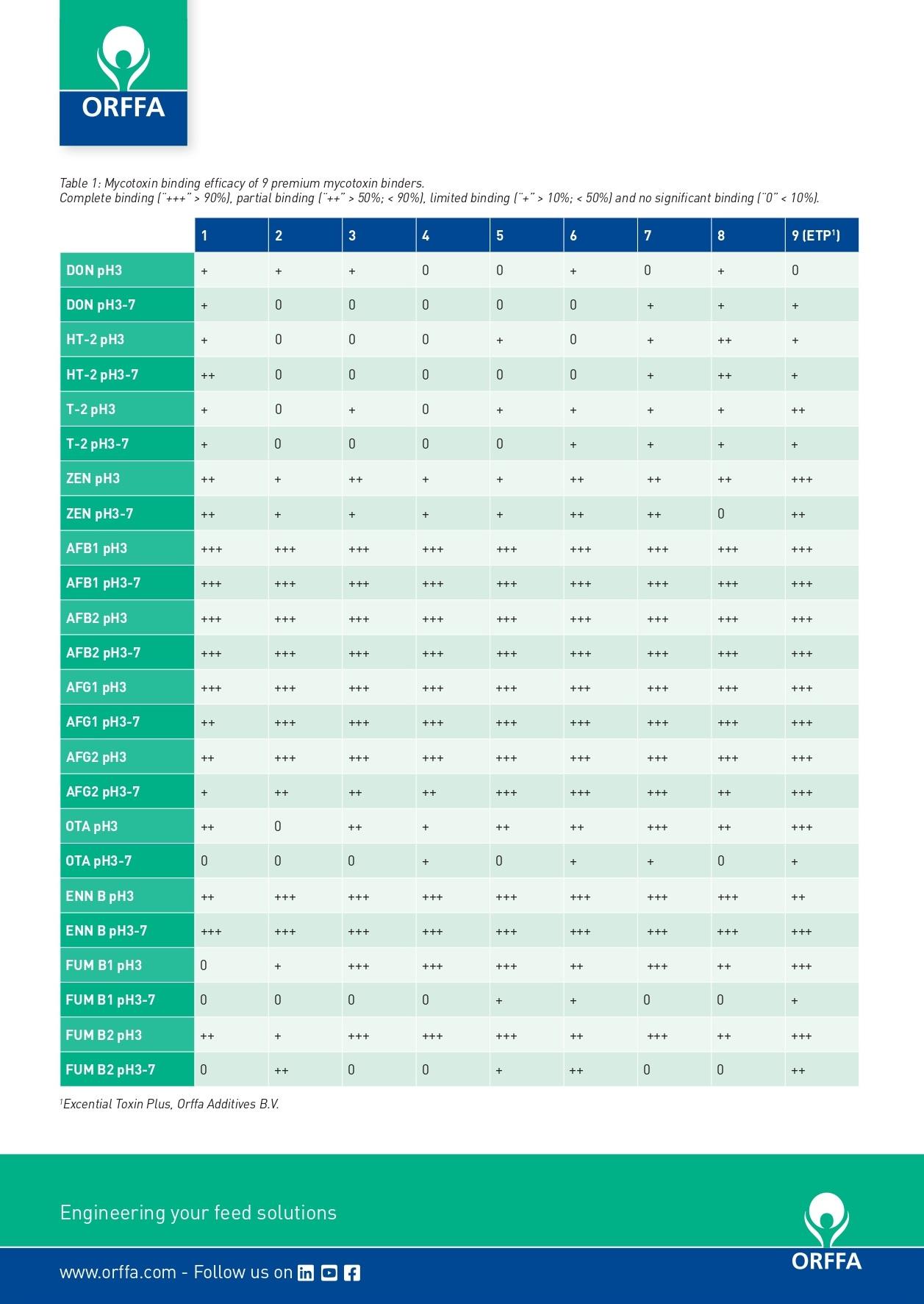Mycotoxin contamination in feed negatively affects animal health and performance. Therefore, the inclusion of a broad spectrum mycotoxin adsorbent in the feed to alleviate this threat is a recommended solution. Commercial mycotoxin binders vary in their capacity to adsorb mycotoxins. In collaboration with Ghent University (Belgium), a benchmark study was performed to compare the binding efficiency of 9 premium mycotoxin binders on the market.
BENCHMARK STUDY
In collaboration with the Centre of Excellence in Mycotoxicology and Public Health at the University of Ghent (Belgium), Orffa set-up an in vitro model to test different commercial products on their capacity to bind mycotoxins (%), via liquid chromatography with tandem mass spectrometry (LC-S/MS). In order to resemble conditions throughout the entire gastrointestinal tract, the binding capacity of the compounds was tested at pH 3 (simulating the stomach) after which it was raised to pH 7 (simulating the intestinal environment).
Mycotoxins included in the test were: trichothecenes (DON, HT-2, T-2), zearalenone (ZEN), afl atoxins (AFB1, AFB2, AFG1, AFG2), ochratoxins (OTA), enniatins (ENN B) and fumonisins (FUM B1, FUM B2). The study included 9 premium mycotoxin binders which are available worldwide (Table 1).
Adsorption capacity, in general, for trichothecenes (DON, HT-2 and T-2) is known to be low. This is confi rmed by the results of this benchmark study, as none of the products are capable of completely binding trichothecenes. For DON, in particular, no premium product is able to bind it to a high extend. Free DON is detected to a high extend in the supernatant of the in vitro model, suggesting that biotransformation into less toxic metabolites is also minimal. In general, all premium products score badly regarding the binding of ZEN, except products 1, 6, 7 and 9. This is in large contrast with the binding of afl atoxins, for which high binding over the full pH range can be observed for all tested products.
Ochratoxins are not bound at all by some products while other products can bind them at pH 3 but lose their binding capacity when pH raises to 7. Similar results were seen for fumonisins, where some premium products lose their binding capacity to a high extend at pH 7. Enniatins are highly bound for both pH 3 and pH 3-7.
NEED FOR A BROAD SPECTRUM SOLUTION
Adsorbents can be the fi rst line of defense inside the animal for some mycotoxins, but there should also be a focus on other defenses since some mycotoxins remain diffi cult to bind. For example, the trichothecenes are not easy to bind and some other mycotoxins like ochratoxins bind in a stomach environment only.
Those mycotoxins will be released at the intestinal level where they will be absorbed, being able to enter the bloodstream and exhibit their toxic effect. This indicates that binding is only part of the solution and highlights the importance of including a broad spectrum solution that not only focusses on binding the mycotoxins, but also uses other strategies to protect the animal against the harmful effects of mycotoxins.
Excential Toxin Plus (product 9) improves mycotoxin defences via a combined approach, by using synergistically working ingredients. Besides the aluminosilicates and yeast aimed at adsorption of mycotoxins, the product also contains ingredients to reduce the growth of fungi in stored feed and to support animals’ health. This unique combination of ingredients makes Excential Toxin Plus a broad spectrum toxin binder, that matches the mycotoxin binding capacities of premium commercial available products, and more!
